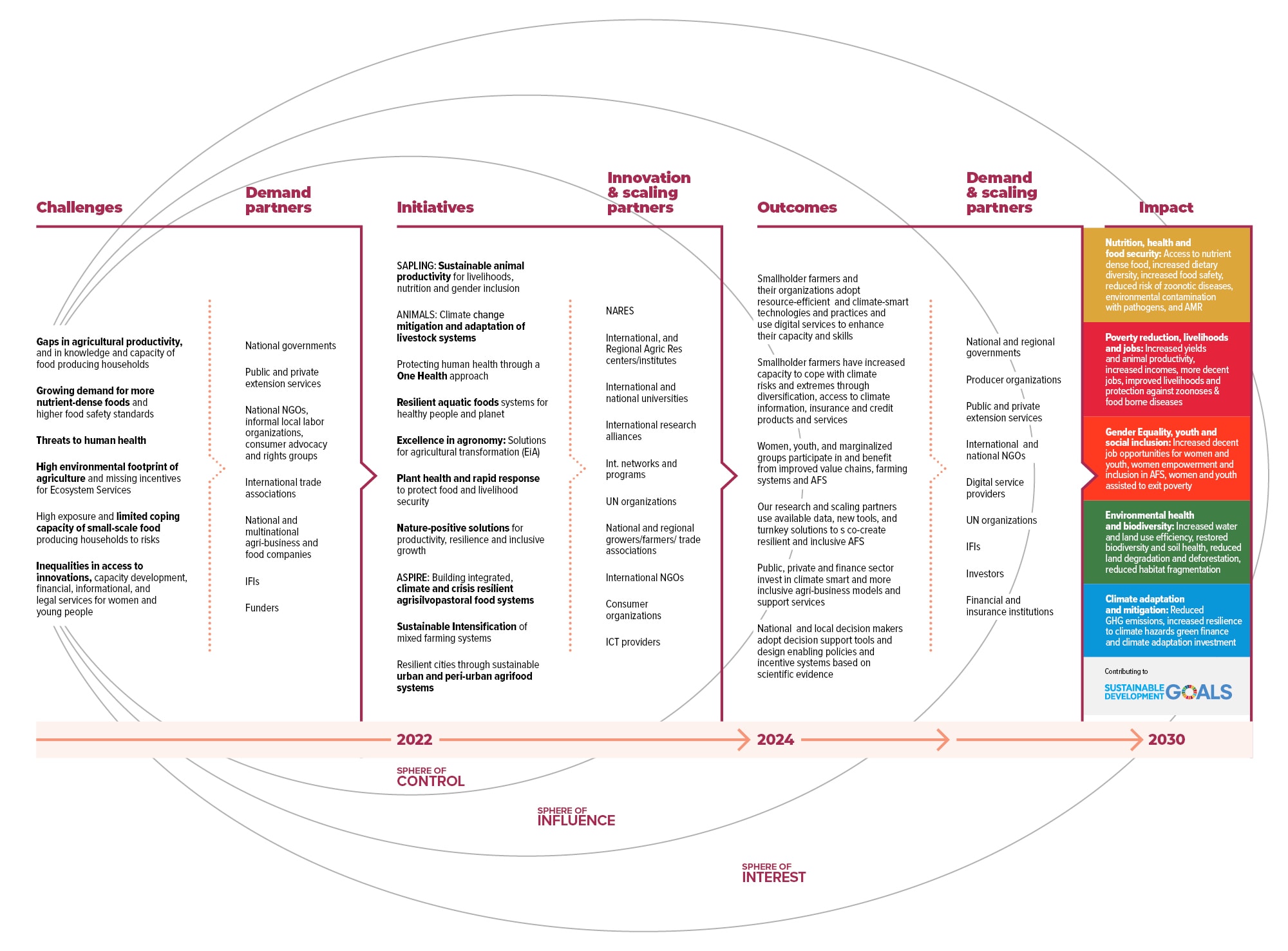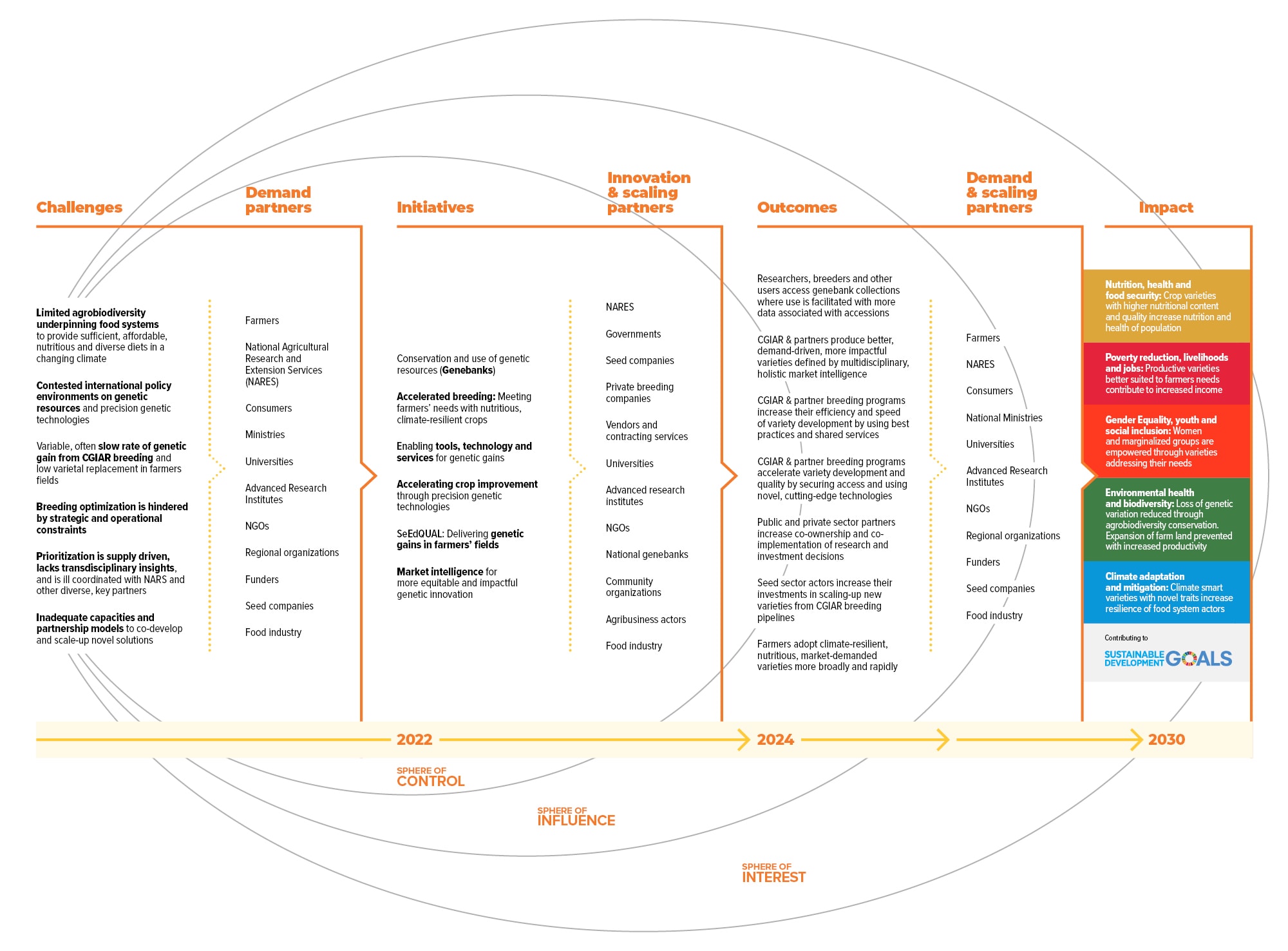As part of the CGIAR 2022–24 Investment Prospectus, 32 Initiatives are grouped within three Action Areas: Systems Transformation, Resilient Agrifood Systems and Genetic Innovation. All Action Areas and the Regional Integrated Initiatives work together drawing on the capabilities of multiple Science Groups and five cross-cutting Impact Area Platforms.
Read more about the CGIAR 2022–24 Investment Prospectus.
Systems Transformation
Agricultural, environmental, energy, health, and societal challenges and risks are emergent properties of complex, interconnected sets of systems. Addressing these will require coordinated action across political and organizational boundaries and scales: from local to global levels, and across the private, public, and civil society spheres.
In the Systems Transformation Action Area, CGIAR commits to forge, with partners, ambitious new multi-sectoral policies and strategies for food, land, and water systems transformation in 50 countries across six regions, via a set of ambitious Initiatives described in the Investment Prospectus.
Achieving these impacts will require practical solutions and close work with partners to achieve change at scale. CGIAR and partners will work to generate and utilize interdisciplinary research to identify transformative, inclusive strategies, innovations, and policies. Partnerships with policymakers, the private sector, and civil society will enable utilization of CGIAR’s innovative tools and data for decision-making — including those developed by the Resilient Agrifood Systems and Genetic Innovation Action Areas — to transform food, land and water systems.
Systems Transformation Theory of Change
| Click to enlarge. Source: CGIAR 2022–24 Investment Prospectus. |
Initiatives in the Systems Transformation Action Area fall into two clusters:
- Initiatives that focus on specific themes and impacts that are central to systems transformation: climate change, biodiversity, sustainability, and resilience; better nutrition and healthy diets; and inclusion, food security, and poverty.
- Initiatives that contribute to systems transformation across themes by improving data and tools, enhancing foresight, measuring impacts, identifying investment priorities and integrating into transformation strategies at global and national levels, and influencing decisions in public and private sectors.
- CGIAR Initiative on Agroecology
- CGIAR Initiative on Climate Resilience
- CGIAR Initiative on Digital Innovation
- CGIAR Initiative on Foresight
- CGIAR Initiative on Fragility, Conflict, and Migration
- CGIAR Initiative on Fruit and Vegetables for Sustainable Healthy Diets (FRESH)
- CGIAR Initiative on Gender Equality
- CGIAR Initiative on Low-Emission Food Systems
- CGIAR Initiative on National Policies and Strategies
- CGIAR Initiative on NEXUS Gains
- CGIAR Initiative on Rethinking Food Markets
- CGIAR Initiative on Sustainable Healthy Diets
Resilient Agrifood Systems
Work in the Resilient Agrifood Systems Action Area addresses the need to increase sustainable agricultural productivity; increase the availability of safe, nutrient-dense foods; reduce threats to human health; improve the environmental footprint of agrifood systems; increase the resilience of smallholder agriculture; and reduce social inequalities. The focus includes mixed farming systems and horticulture, linking closely with the work on sustainable healthy diets in the Systems Transformation Action Area.
The expected outcomes of this Action Area include more decent jobs, stable livelihoods, gender equality, and affordable nutritious food, and co-benefits for soil health, water security, biodiversity, and climate change.
Resilient Agrifood Systems Theory of Change
| Click to enlarge. Source: CGIAR 2022–24 Investment Prospectus. |
Initiatives in the Resilient Agrifood Systems Action Area fall into three clusters:
- Crops
- Livestock and aquatic foods
- Farming systems. The three Initiatives in the farming systems cluster address drylands, non-drylands and urban-rural farming systems respectively.
- CGIAR Initiative on AgriLAC Resiliente
- CGIAR Initiative on Aquatic Foods
- CGIAR Initiative on Asian Mega-Deltas
- CGIAR Initiative on Diversification in East and Southern Africa
- CGIAR Initiative on Excellence in Agronomy
- CGIAR Initiative on Fragility to Resilience in Central and West Asia and North Africa
- CGIAR Initiative on Livestock and Climate
- CGIAR Initiative on Mixed Farming Systems
- CGIAR Initiative on Nature-Positive Solutions
- CGIAR Initiative on One Health
- CGIAR Initiative on Plant Health
- CGIAR Initiative on Resilient Cities
- CGIAR Initiative on Sustainable Animal Productivity
- CGIAR Initiative on Transforming Agrifood Systems in South Asia
- CGIAR Initiative on West and Central Africa Food Systems Transformation
Genetic Innovation
Work in the Genetic Innovation Action Area stewards genetic resources and addresses barriers to achieving rapid improvement of crop varieties, thereby increasing genetic gain and varietal turnover in farmers’ fields. This is accomplished through:
- Conserving genetic resources in genebanks and facilitating and expanding their use by breeders and other stakeholders;
- Prioritizing breeding investments in market segments with the highest potential for impact;
- Developing new crop varieties that deliver higher rates of genetic gain in farmers’ fields;
- Accelerating crop improvement through precision genetic technologies;
- Enabling tools, technology, and shared services to enhance efficiency and effectiveness of CGIAR and partners’ breeding programs; and
- Increasing seed sector actors’ investments and effectiveness in scaling up access for farmers to new varieties.
Investments in genetic innovations will provide foundational and multiplier outputs and outcomes for many crop-related innovations such as increased yield, biofortification, pest and disease resistance, and improved environmental tolerances that, in turn, deliver benefits across all five Impact Areas.
Genetic Innovation Theory of Change
| Click to enlarge. Source: CGIAR 2022–24 Investment Prospectus. |
The Initiatives in the Genetic Innovation Action Area fall into a single cluster and will work across all six CGIAR regions.
Interlinkages among Action Areas
While the three Action Areas stand independently, they are also interconnected. For instance, efforts to improve resilience in agrifood systems must go hand in hand with efforts to halt and reverse forest loss and degradation, as well as with the selection of crop traits that fit consumer and producer needs and preferences. Similarly, on-farm water management takes place in the broader context of watersheds, river basins, and groundwater systems.
Header image: Photo by Isabel Corthier/CIP
Photo 1: Photo by Ayush Manik
Photo 2: Photo by Neil Palmer/WorldFish
Photo 3: Photo by N. Capozio/Bioversity International




